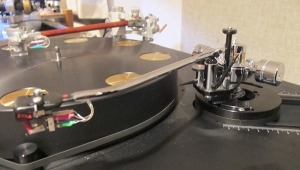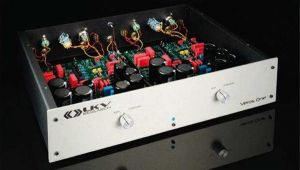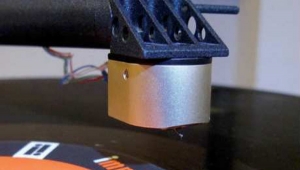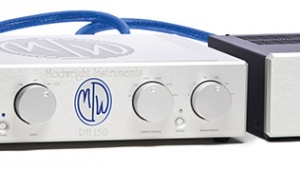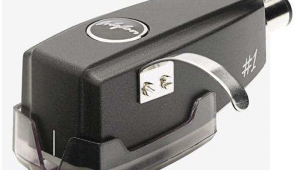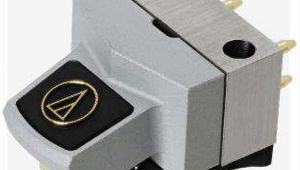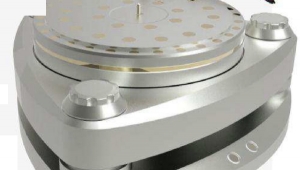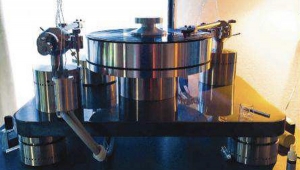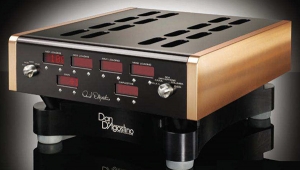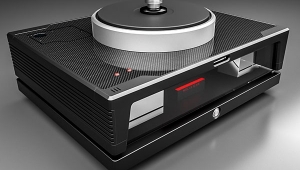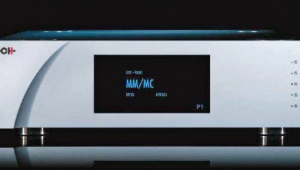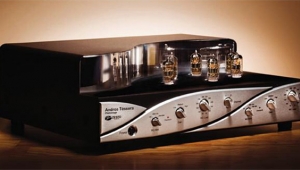| Columns Retired Columns & Blogs |
Analog Corner #252: Sony PS-HX500 USB turntable & GEM Dandy PolyTable

Recently, when a reader questioned my hearing acuity on account of my age—I'm 69—I didn't argue: I don't hear as well as I did when I was 40, or 50, or even 60, and it would be foolish to claim otherwise. However, while my hearing isn't what it once was, neither is my listening—which has never been better. Audio perception is a combination of what the ear delivers and what the brain does with it.
Footnote 1: Sony Electronics, Inc., 16530 Via Esprillo, San Diego, CA 92127-1708. Tel: (858) 942-2400. Web: www.sony.com
A while back, I visited an audio store to give a presentation. Before the public arrived, I sat down with some veteran audio manufacturers who were contentedly listening to a system that contained one guy's speakers and another guy's electronics. But to me, something sounded wrong. When I moved my head, it sounded as if the speakers' woofers had been wired out of phase (the speakers were bi-amped). My opinion was met by surprise, but it turned out I was right. Save No.1.
At a different event at a different store—again, shortly before the doors opened—a different group of manufacturers sat contentedly listening to a pair of highly regarded speakers. Again, something sounded wrong to me, this time more subtly. I stood up, put my ear to each driver in turn, and found that one speaker's midrange driver wasn't working. Turned out its protection circuitry had kicked in, so it was an easy fix—but if I hadn't noticed it, the public would have heard less-than-excellent sound; at worst, an attendee would have discovered the problem, which would have been pretty embarrassing for the store and the manufacturer. Save No.2.
Last May, at the 2016 Munich High End Show, I walked into a room and asked to play Turkish drummer Ferit Odman's all-analog, self-produced Dameronia with Strings (LP, Audio & Video Labs 5638509530), the first pressing of which has sold out. Everywhere I play it, people take pictures and write down Odman's name, and the album's title and label. The musicianship is outstanding, and the arrangements, featuring a string sextet, of the late Tadd Dameron's compositions are subtly lush and swinging. And it's a superb recording.
The host put on the first cut. Within seconds, it was obvious that something was wrong.
"Hey, that's mono!" I exclaimed. "This record is stereo."
The host got up to examine the phono preamp's Stereo/Mono switch. "Nope!" He was obviously relieved. "It's set to Stereo."
"But it's playing in mono," I insisted.
"Well, no one else has complained!"
I didn't argue further, other than to say, as I left, "You're playing records in mono. Trust me."
On the next-to-last day of High End, I returned to the room to see if they'd finally figured it out. "You were correct," he sheepishly admitted. "It was playing in mono, even though everything was set for stereo."
It turned out that someone had inserted, in the phono preamp's unused set of inputs, a noise-blocking gizmo that connected the two jacks. Even though the input wasn't being used, it was electronically connected to the input that was being used, which produced the mono signal that I and apparently no one else, including pairs of much younger ears, had heard. Save No.3.
My upper-octave response still sounds to be all there. Are there some lumps and bumps below? Probably. And some tinnitus noise encroaching on very-low-level material? No denying it. But as far as I'm concerned, at least for now, I'm still quite capable of doing this job.
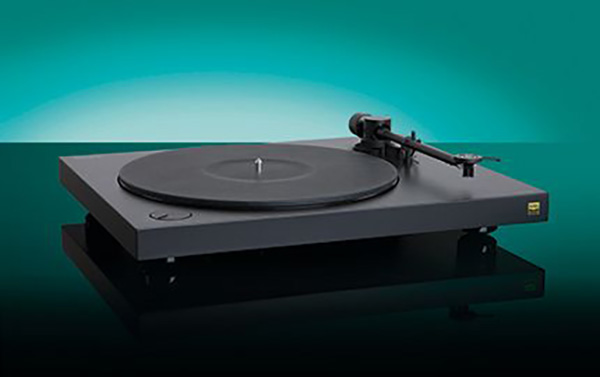
Sony PS-HX500 USB turntable
Decades ago, Sony introduced what is still considered to be one of the finest turntables ever made: the PS-X9, a direct-drive model with a 15" platter and built-in phono preamplifier. Only a few thousand were made. Sony also produced the XL-88D, a moving-coil phono cartridge with a one-piece diamond stylus-and-cantilever assembly. Among vinyl cognoscenti, these products are legendary; two years ago, a combination of PS-X9 and XL-88D sold online for almost $10,000.
Clearly, Sony is, or was, capable of mounting an assault on the state of the record-playing art. Clearly, their new belt-driven PS-HX500 USB turntable ($599.99) is not part of that assault (footnote 1). But neither is it a cheap, hollow-bodied assemblage of off-the-shelf plastic parts. Rather, Sony has produced a new tonearm (8.7" effective length) to which is attached a round, die-cast headshell, both made of aluminum alloy. The arm offers no way to adjust vertical tracking angle (VTA), stylus rake angle (SRA), or azimuth, which puts it at a disadvantage compared to other arms on similarly priced 'tables. But at this price it can easily be argued that stability and rigidity trump adjustability, and the PS-HX500's arm gives the cartridge a rigid, stable ride. I appreciated the robustness of the counterweight stub, as well as what appeared to be a brass insert in the counterweight.
Sony doesn't identify the cartridge they include in the price, which is unfortunate. It appears to be one of Audio-Technica's 3600 series, which output 3mV and track at 3gm. The PS-HX500's manual says you can contact Sony for a replacement stylus, if necessary, but you can probably get one more easily than that.
The platter is driven by a DC motor powered by a wall wart. The speed (33 1/3 or 45rpm) is selected with a rotary switch mounted flush with the plinth; this switch also turns the 'table on without starting the platter spinning, to enable the 'table's A/D converter to communicate, via its USB 2.0 output, with your Windows or Apple computer.
The PS-HX500's lightweight platter is of die-cast aluminum alloy, topped by a heavy, 0.2"-thick rubber mat that's concave in the label area. The reasonably well-damped, 1.18"-tall MDF plinth is relatively heavy and rests on four insulating feet developed by Sony. The 'table weighs 12lb; considering its lightweight platter, this means that the plinth is probably well reinforced and damped.
The electronic star of the show is a high-resolution A/D converter capable of converting analog signals to up to 24-bit/192kHz PCM or DSD128 (5.6MHz) resolution. The built-in moving-magnet phono preamp can be switched out so that you can use your own. However, if you want to use the PS-HX500 to convert your vinyl to digital, the built-in phono preamp is your only choice.
Sony provides Windows- and Mac-based downloadable software that's remarkably intuitive and easy to use, though that ease of use will somewhat depend on how familiar you are with recording and editing programs such as Audacity. But even without such experience, a few minutes spent learning the program—a process I won't walk you through here—should have you up and editing your files with relative ease.
Setup and Use: I found it fairly easy to unpack and set up the PS-HX500, though it lacks leveling feet: you'll need to place it on a level surface. On the rear panel are gold-plated RCA output jacks, a Line/Phono switch, and the USB 2.0 port. The package also includes a hinged dustcover, a 4.9'-long phono cable with gold-plated RCA plugs, and a 6.6'-long USB cable.
I listened to the PS-HX500 using its built-in MM phono preamp, as well as with outboard phono preamps; of the latter, the nearest to hand and most convenient was the TLA (True Life Audio) Argo, a tubed model from Greece that in Europe costs €15,700 ($18,000). A ridiculous pairing? Yes, but why not? It was two shelves below the Sony. I also tried the superb yet reasonably priced Lejonklou Gaio ($895), soon to be reviewed on AnalogPlanet.com.
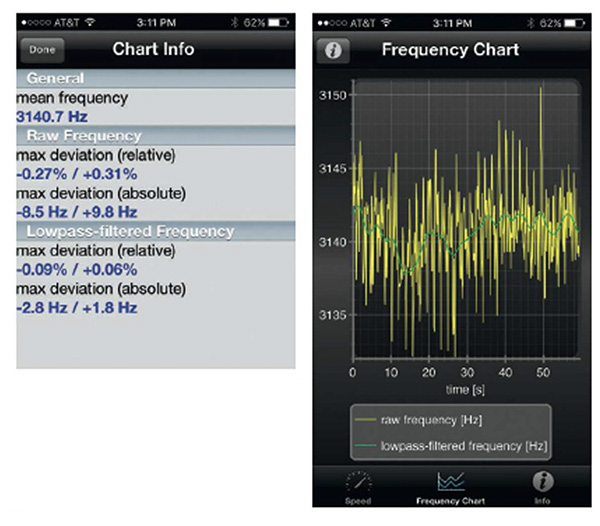
Figs.1 & 2 Sony PS-HX500, speed stability data and speed stability (raw frequency yellow; low-pass filtered frequency green).
Using the Sony's built-in phono preamp, I first measured the accuracy of the PS-HX500's speed and speed stability using the Dr. Feickert Analogue PlatterSpeed app. The PS-HX500 reproduced the Adjust+ test LP's 3150Hz test tone as 3140.7Hz (fig.1), which meant that the review sample was running about 0.3% slow. The speed-stability graph (fig.2) isn't exactly pretty, but, as is often the case with such measurements, the PS-HX500 sounded far better than the graph indicated. I couldn't hear any of the measured fluctuations in speed, even on sustained notes. Some manufacturers seem to deliberately set their 'tables to run fast, to produce aural excitement; whether or not it was a deliberate choice, the Sony's slight slowness may have helped produce its warm, inviting sound and velvety-"black" backgrounds. I found it an antidote to digital "tinkle tinkle" sound.
The PS-HX500's tonearm was particularly well behaved, both in the groove and in the smooth functioning of its cueing mechanism. In fact, I had no reservations about playing a test pressing of the Electric Recording Company's reissue, already sold out, of Leonid Kogan's 1959 recording of Beethoven's Violin Concerto, with Constantin Silvestri conducting the Paris Conservatoire Orchestra (LP, EMI SAX 2386/ERC ERC005). The sound of this record on this turntable, even through the built-in phono preamp, was sweet, rich, reasonably well detailed, and completely enjoyable. Once the concerto had begun, there was no stopping; that I could simultaneously and easily rip it to DSD128 was an added pleasure.
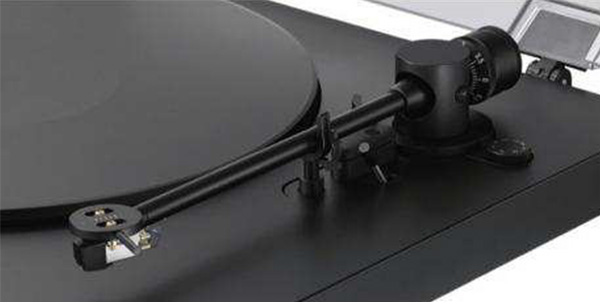
The PS-HX500's bottom end was surprisingly well controlled and well extended, with no upper-midbass resonant "leakage." The midrange was rich and full, and the upper frequencies were smooth and also well extended, with clean, precise transients. All this from a presumably very inexpensive cartridge.
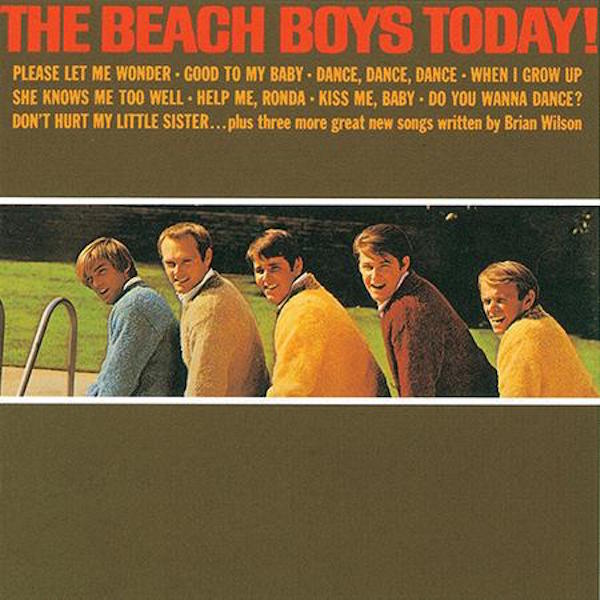
I sat fully engaged through the new true-stereo reissue of the Beach Boys' Today! (LP, Capitol/Analogue Reproductions APP064), originally issued only in mono or Duophonic (fake stereo). I was impressed by the Sony's well-extended bottom octaves and clean upper-frequency transients, and especially by the stability of the soundstage. This album has sustained, deep, forceful bass and cleanly rendered high-frequency percussive transients, neither of which the modest Sony much diminished, though it was clearly the component providing the pervasive warmth I heard. Still, that consistent warmth, spread evenly throughout the audioband, was one mighty pleasing artifact.
A few days and evenings spent with the PS-HX500 reinforced the notion that, even at so low a price, a properly designed turntable can do some attractive analog things that no digital system at any price has yet managed.
Footnote 1: Sony Electronics, Inc., 16530 Via Esprillo, San Diego, CA 92127-1708. Tel: (858) 942-2400. Web: www.sony.com
- Log in or register to post comments

